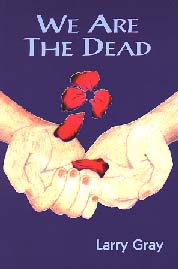|
________________
CM . . . .
Volume VII Number 20 . . . . June 8, 2001
excerpt: War kills! War mains! Both bodies and minds are ruptured. What was the experience like? An oft-asked question from those who stayed behind but seldom answered. Witnesses of war rarely choose to remember. Today there is almost no one left to answer. Children and grandchildren comment that their fathers and grandfathers never talked about the war. They feel a part of their heritage is empty because of this deficiency.In the more than eighty years since its conclusion, we have accumulated an extensive historical legacy of the World War I or the Great War as it was first known. In more recent years, we have seen the growth of a particularly rich portion of that legacy: the contribution made by Canada to that conflict. Some of this history has attempted to paint the broad themes and events; other studies have attempted to trace the experiences of individual participants. In War Are the Dead, Larry Gray has offered yet another and very powerful perspective: that of a small Canadian town. On the encouragement of his wife, a high school teacher in Carleton Place, Ontario, Gray, himself a retired serviceman, brings back to life the fifty-one names of the war dead appearing on the town's war memorial. By the effective use of personal correspondence, photographs, military reports, war poetry, newspaper accounts and archival records, he is able to put flesh on those almost impersonal surnames and initials: giving us a sense of their background, childhood, war experience, and the circumstances of their deaths (which might be in the midst of battle, or in a later succumbing to wounds or other "war effects," like gas poisoning). The town, itself, is sketched in backdrop. Carleton Place has a long record of military and militia service, from its origins as a settlement of demobilized soldiers after the War of 1812, and on through the Upper Canada Rebellion, the Fenian Raids, the Boer War, and, inevitably, the Great War. With this legacy behind them, its young went readily and almost as a matter of course and duty which makes the inordinate loss suffered by the community all the more poignant. Tellingly, Gray makes his dedication to "the children of Carleton Place who gave their lives during the Great War to end all Wars." While the focus is on the individuals, themselves, their stories are recounted very effectively against a carefully drawn background of the progress and strategy of the war generally and of the Canadian Corps particularly (assisted by a useful set of maps). We follow the Corps through the Somme, Ypres, Passchendaele, Vimy, Arras and Cambrai, and see the deaths of individuals within those mammoth conflicts. The author presents another layer of cross-hatching to the story, tracing such themes as the machine gun, artillery, trench raids, air combat, medics, and railroads again placing individuals, and their deaths, within those separate stories. In all of this, we see as well the details of daily life on the Western Front: the routines, the living conditions, the experience of the wounded. A good deal is accomplished by this book. Through this kind of retrieval of individual stories, new generations can be made to appreciate the human dimension of almost forgotten names carved on now seemingly ancient monuments. They can see the meaning of war for those directly serving and fighting - and, just as significantly, for the communities raised them. This, in comparison to abstract sentiment, is a powerful way to understand the experience of war and to acknowledge those who, in different ways, were part of it. In his conclusion, Gray notes that "if this work inspires one grandchild, or great-grandchild, to discover the service of a forebear who answered a nation's call, and perhaps never returned, then its purpose has been achieved." There is no question that the author has accomplished his goal: not just for the descendants of the Carleton Place contingent, but for anyone looking back to one of the major shaping events in our country's history. Recommended. Alexander D. Gregor is Associate Dean (Graduate Studies and Research), in the Faculty of Education, University of Manitoba.
To comment on this title or this review, send mail to cm@umanitoba.ca.
Copyright © the Manitoba Library Association.
Reproduction for personal use is permitted only if this copyright notice
is maintained. Any other reproduction is prohibited without
permission.
Published by
TABLE OF CONTENTS FOR THIS ISSUE - May 25, 2001.
AUTHORS |
TITLES |
MEDIA REVIEWS |
PROFILES |
BACK ISSUES |
SEARCH |
ORDER |
CMARCHIVE |
HOME
|
